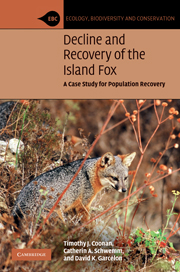Book contents
- Frontmatter
- Contents
- Foreword
- Acknowledgments
- 1 Introduction
- 2 Evolution and genetics
- 3 Social structure, reproduction, mortality and survivorship, and population dynamics
- 4 Food habits, habitat use, activity patterns, and dispersal
- 5 Golden eagles and the decline on the northern islands
- 6 Ecosystem recovery
- 7 Disease and decline on Santa Catalina Island
- 8 Recovery actions
- 9 Recovery actions
- 10 Reproductive biology, by Cheryl Asa
- 11 Diseases of island foxes, by Linda Munson
- 12 Zoos, education, and public participation
- 13 Managing recovery
- 14 The ecological role of island foxes
- 15 Conclusion
- References
- Index
3 - Social structure, reproduction, mortality and survivorship, and population dynamics
Published online by Cambridge University Press: 05 October 2010
- Frontmatter
- Contents
- Foreword
- Acknowledgments
- 1 Introduction
- 2 Evolution and genetics
- 3 Social structure, reproduction, mortality and survivorship, and population dynamics
- 4 Food habits, habitat use, activity patterns, and dispersal
- 5 Golden eagles and the decline on the northern islands
- 6 Ecosystem recovery
- 7 Disease and decline on Santa Catalina Island
- 8 Recovery actions
- 9 Recovery actions
- 10 Reproductive biology, by Cheryl Asa
- 11 Diseases of island foxes, by Linda Munson
- 12 Zoos, education, and public participation
- 13 Managing recovery
- 14 The ecological role of island foxes
- 15 Conclusion
- References
- Index
Summary
Prior to the 1990s, studies of island foxes focused on their biology and basic ecological relationships in island systems. Several important studies provided the foundation for what we now know about productivity, abundance, food habits, and genetics (Laughrin 1977, Collins and Laughrin 1979, Kovach and Dow 1981, Collins 1982, Fausett 1993, Wayne et al. 1991b, Crooks and Van Vuren 1995, Moore and Collins 1995, Crowell 2001). The natural history approach to studying island foxes ended in 1993 when Gary Roemer (then of the University of California, Los Angeles) began research on Santa Cruz Island that would ultimately reveal the devastating effects of golden eagle (Aquila chrysaetos) predation on foxes (Roemer 1999; see Chapter 5). Roemer (1999) initially focused on island biogeography and the ecology and social structure of fox populations, but as increasing numbers of his study animals fell prey to golden eagles his research shifted to determining the effects of eagles on the entire Santa Cruz population and the conservation actions that would be required to avoid extinction of that population.
A few years later, canine distemper virus (CDV) was introduced to the island fox population on Santa Catalina, resulting in the loss of nearly three-quarters of the entire population in one year (Timm et al. 2009; see Chapter 7).
- Type
- Chapter
- Information
- Decline and Recovery of the Island FoxA Case Study for Population Recovery, pp. 21 - 33Publisher: Cambridge University PressPrint publication year: 2010
- 1
- Cited by



